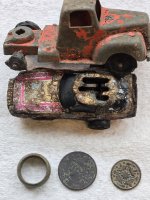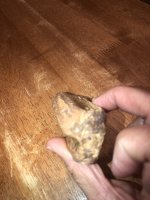Silver Tree Chaser
Bronze Member
It appeared as though 2017 would be a sparse year for older silver coins, but an outing last week has made all the difference.  Until last week, my oldest silver coin found over the past 11 months was an 1898 Barber dime. Living in New England affords wonderful opportunities for finding Colonial Period silver coins, but there are no guarantees. Last week I was at “Old Faithful”
Until last week, my oldest silver coin found over the past 11 months was an 1898 Barber dime. Living in New England affords wonderful opportunities for finding Colonial Period silver coins, but there are no guarantees. Last week I was at “Old Faithful”  — a farm so named for its past offerings over many years — a 1652 Oak Tree shilling (my avatar), a 1693 Arabian silver coin connected to Red Sea piracy, Spanish silver cobs, coppers, latten spoon fragments, spur buckles, etc.
— a farm so named for its past offerings over many years — a 1652 Oak Tree shilling (my avatar), a 1693 Arabian silver coin connected to Red Sea piracy, Spanish silver cobs, coppers, latten spoon fragments, spur buckles, etc.
The site’s only disadvantage is a minimum number of fields subject to seasonal plowing. This obstacle proved ever more challenging on my most recent trip, as I noticed that one often plowed field was now planted with a multi-year crop, i.e., no more plowing. It was a well located field that had produced some good finds over several years of plowing — a good number of coppers and a pristine Liberty Seated half-dime, but I never pulled any Colonial Period silver from this choice location. This most recent plowing of the soil however, this one last tilling of the soil for years to come, had finally pulled up a prized coin from a depth beyond the capabilities of my detector and all my prior searching. I walked the edge of the field on my way to another area and noticed a wide border of bare dirt that permitted some fast sweeping. My walking slowed down to a slower pace and sweep as I dug a small piece of lead, a hot rock, and a third signal. I initially suspected another hot rock but noticed its numbers ran too high and consistent. After a bit of shoveling, my pinpointer located a small clod of dirt that yielded a tiny bent disc of metal dark gray in color with highpoints of bright silver.
It was a well located field that had produced some good finds over several years of plowing — a good number of coppers and a pristine Liberty Seated half-dime, but I never pulled any Colonial Period silver from this choice location. This most recent plowing of the soil however, this one last tilling of the soil for years to come, had finally pulled up a prized coin from a depth beyond the capabilities of my detector and all my prior searching. I walked the edge of the field on my way to another area and noticed a wide border of bare dirt that permitted some fast sweeping. My walking slowed down to a slower pace and sweep as I dug a small piece of lead, a hot rock, and a third signal. I initially suspected another hot rock but noticed its numbers ran too high and consistent. After a bit of shoveling, my pinpointer located a small clod of dirt that yielded a tiny bent disc of metal dark gray in color with highpoints of bright silver.
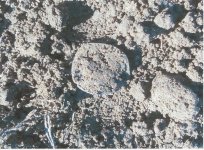
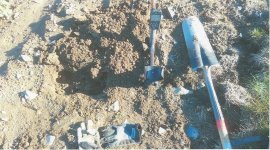
Upon close examination, I noticed a beaded circle design on this apparent coin — a sure sign that I had just recovered a Massachusetts silver coin. I rinsed the coin with a bottle of water as well as I could manage. During the first few moments, I figured that I could have the coin straightened by a jeweler perhaps, but I was getting ahead of myself. In attempting to determine the coin’s denomination - a two-pence or a three-pence — I blew the last clod of dirt right through the coin. “Oh God — I ruined the coin!
I rinsed the coin with a bottle of water as well as I could manage. During the first few moments, I figured that I could have the coin straightened by a jeweler perhaps, but I was getting ahead of myself. In attempting to determine the coin’s denomination - a two-pence or a three-pence — I blew the last clod of dirt right through the coin. “Oh God — I ruined the coin!  No — Keep calm! It was holed long ago. Breathe. Inhale. Exhale.”
No — Keep calm! It was holed long ago. Breathe. Inhale. Exhale.”
The coin is a 1662 Oak Tree twopence, Noe-32 variety. About 1/3 the weight of a modern US dime, it’s smaller and much thinner.
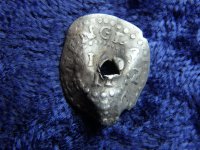
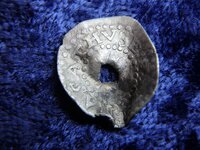
The method of punching a hole in this coin is odd. It appears that the coin was holed over an uneven surface and the coin was bent in the process.
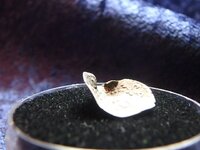
In most holed coins, the displaced silver is absorbed around the outside of the hole resulting in bead of raised silver. The displaced silver on this twopence is splayed out in sections extending away from the coin. There is also a small crevice in the coin further out from the center. The oddly-shaped hole is a bit interesting, although I would certainly prefer having avoided the matter entirely with the recovery of an unmarred coin. Excluding a cut piece of a shilling from a few years back, it’s been 11 years since I recovered my first Mass Silver coin, so I’m glad to have another coin in any condition.
So what to do with the coin’s current appearance? A highly-skilled silversmith is willing to straighten the coin. While he can possibly close the perforation as well, he will not fill and doctor the hole, which is to be expected. Should I have the splayed silver from the puncture folded back into place? It may result in a better view of the coin’s details (date), but I’m more inclined to leave the hole as I found it and preserve the coin’s history of use. I’ve read that collectors are more forgiving of holed coins from the Colonial Period, of which Spanish cobs and Mass Silver are best known for their rustic charm. The silversmith believes that the coin can perhaps be straightened without annealing. It would be better to not expose the coin to a torch as part of the annealing process, but will there be a greater risk of snapping the coin? I’ve seen video from England in which annealing hammered coins appears to be a standard practice. I appreciate any suggestions or opinions on how to best restore this coin, so please weigh-in with your own two-cents (or two-pence
A highly-skilled silversmith is willing to straighten the coin. While he can possibly close the perforation as well, he will not fill and doctor the hole, which is to be expected. Should I have the splayed silver from the puncture folded back into place? It may result in a better view of the coin’s details (date), but I’m more inclined to leave the hole as I found it and preserve the coin’s history of use. I’ve read that collectors are more forgiving of holed coins from the Colonial Period, of which Spanish cobs and Mass Silver are best known for their rustic charm. The silversmith believes that the coin can perhaps be straightened without annealing. It would be better to not expose the coin to a torch as part of the annealing process, but will there be a greater risk of snapping the coin? I’ve seen video from England in which annealing hammered coins appears to be a standard practice. I appreciate any suggestions or opinions on how to best restore this coin, so please weigh-in with your own two-cents (or two-pence  ) of advice if you wish.
) of advice if you wish.
And what of my remaining search of the property? I phoned the farmer, who I’ve known for many years, about the twopence, and he gave me permission to search the planted field. The up and down contour of the ground made for difficult hunting, but I managed one more early find, a partial latten spoon. It was likely a seal handle variety dating from the 17th century to early 18th century. The maker’s mark on the spoon is too far gone with surface corrosion to identify. In an adjacent field, I also found a spur buckle fragment, dating to the 1680s with decorative rosettes. Three finds over the course of several hours of searching, but what the site lacked in quantity was made up ten-fold in quality.
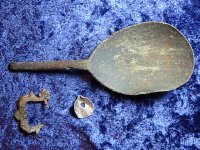
Sorry for the long details on this recovery, but it’s not like I’ll be posting such finds anytime soon — then again, who knows? Let’s stay positive and see what happens! I wanted to post some information of the whole subject of putting holes in coins. For those of us searching for old colonial coins, it seems like such a horrendous practice. Perhaps the topic can be discussed in this thread?
Finally, I mentioned the earlier recovery of a 1693 Arabian silver coin from the same site that produced the two-pence. I posted it back in 2014 when it made the banner. I recently authored a 43-page article on this coin and other similar Arabian coins all recovered in Southern New England and all connected to piracy on the Red Sea at the close of the 17th Century. The article was published in the Colonial Newsletter, a research journal published by the American Numismatic Society. With the recovery of this latest Mass Silver, it would seem an appropriate time for a long overdue update of the thread titled “1693 Hammered Silver — A Pirate’s Coin.” Keep a look out for this thread if interested. My published research connects these Arabian coins found by New England detectorists, including some posted here on T-Net, to one of the greatest piracies in history — the plundering of the Mughal treasure ship, Gunsway, by Captain Henry Every of the Fancy in 1695!


Good Hunting!
 Until last week, my oldest silver coin found over the past 11 months was an 1898 Barber dime. Living in New England affords wonderful opportunities for finding Colonial Period silver coins, but there are no guarantees. Last week I was at “Old Faithful”
Until last week, my oldest silver coin found over the past 11 months was an 1898 Barber dime. Living in New England affords wonderful opportunities for finding Colonial Period silver coins, but there are no guarantees. Last week I was at “Old Faithful”  — a farm so named for its past offerings over many years — a 1652 Oak Tree shilling (my avatar), a 1693 Arabian silver coin connected to Red Sea piracy, Spanish silver cobs, coppers, latten spoon fragments, spur buckles, etc.
— a farm so named for its past offerings over many years — a 1652 Oak Tree shilling (my avatar), a 1693 Arabian silver coin connected to Red Sea piracy, Spanish silver cobs, coppers, latten spoon fragments, spur buckles, etc. The site’s only disadvantage is a minimum number of fields subject to seasonal plowing. This obstacle proved ever more challenging on my most recent trip, as I noticed that one often plowed field was now planted with a multi-year crop, i.e., no more plowing.
 It was a well located field that had produced some good finds over several years of plowing — a good number of coppers and a pristine Liberty Seated half-dime, but I never pulled any Colonial Period silver from this choice location. This most recent plowing of the soil however, this one last tilling of the soil for years to come, had finally pulled up a prized coin from a depth beyond the capabilities of my detector and all my prior searching. I walked the edge of the field on my way to another area and noticed a wide border of bare dirt that permitted some fast sweeping. My walking slowed down to a slower pace and sweep as I dug a small piece of lead, a hot rock, and a third signal. I initially suspected another hot rock but noticed its numbers ran too high and consistent. After a bit of shoveling, my pinpointer located a small clod of dirt that yielded a tiny bent disc of metal dark gray in color with highpoints of bright silver.
It was a well located field that had produced some good finds over several years of plowing — a good number of coppers and a pristine Liberty Seated half-dime, but I never pulled any Colonial Period silver from this choice location. This most recent plowing of the soil however, this one last tilling of the soil for years to come, had finally pulled up a prized coin from a depth beyond the capabilities of my detector and all my prior searching. I walked the edge of the field on my way to another area and noticed a wide border of bare dirt that permitted some fast sweeping. My walking slowed down to a slower pace and sweep as I dug a small piece of lead, a hot rock, and a third signal. I initially suspected another hot rock but noticed its numbers ran too high and consistent. After a bit of shoveling, my pinpointer located a small clod of dirt that yielded a tiny bent disc of metal dark gray in color with highpoints of bright silver. 

Upon close examination, I noticed a beaded circle design on this apparent coin — a sure sign that I had just recovered a Massachusetts silver coin.
The coin is a 1662 Oak Tree twopence, Noe-32 variety. About 1/3 the weight of a modern US dime, it’s smaller and much thinner.


The method of punching a hole in this coin is odd. It appears that the coin was holed over an uneven surface and the coin was bent in the process.

In most holed coins, the displaced silver is absorbed around the outside of the hole resulting in bead of raised silver. The displaced silver on this twopence is splayed out in sections extending away from the coin. There is also a small crevice in the coin further out from the center. The oddly-shaped hole is a bit interesting, although I would certainly prefer having avoided the matter entirely with the recovery of an unmarred coin. Excluding a cut piece of a shilling from a few years back, it’s been 11 years since I recovered my first Mass Silver coin, so I’m glad to have another coin in any condition.
So what to do with the coin’s current appearance?
 A highly-skilled silversmith is willing to straighten the coin. While he can possibly close the perforation as well, he will not fill and doctor the hole, which is to be expected. Should I have the splayed silver from the puncture folded back into place? It may result in a better view of the coin’s details (date), but I’m more inclined to leave the hole as I found it and preserve the coin’s history of use. I’ve read that collectors are more forgiving of holed coins from the Colonial Period, of which Spanish cobs and Mass Silver are best known for their rustic charm. The silversmith believes that the coin can perhaps be straightened without annealing. It would be better to not expose the coin to a torch as part of the annealing process, but will there be a greater risk of snapping the coin? I’ve seen video from England in which annealing hammered coins appears to be a standard practice. I appreciate any suggestions or opinions on how to best restore this coin, so please weigh-in with your own two-cents (or two-pence
A highly-skilled silversmith is willing to straighten the coin. While he can possibly close the perforation as well, he will not fill and doctor the hole, which is to be expected. Should I have the splayed silver from the puncture folded back into place? It may result in a better view of the coin’s details (date), but I’m more inclined to leave the hole as I found it and preserve the coin’s history of use. I’ve read that collectors are more forgiving of holed coins from the Colonial Period, of which Spanish cobs and Mass Silver are best known for their rustic charm. The silversmith believes that the coin can perhaps be straightened without annealing. It would be better to not expose the coin to a torch as part of the annealing process, but will there be a greater risk of snapping the coin? I’ve seen video from England in which annealing hammered coins appears to be a standard practice. I appreciate any suggestions or opinions on how to best restore this coin, so please weigh-in with your own two-cents (or two-pence  ) of advice if you wish.
) of advice if you wish. And what of my remaining search of the property? I phoned the farmer, who I’ve known for many years, about the twopence, and he gave me permission to search the planted field. The up and down contour of the ground made for difficult hunting, but I managed one more early find, a partial latten spoon. It was likely a seal handle variety dating from the 17th century to early 18th century. The maker’s mark on the spoon is too far gone with surface corrosion to identify. In an adjacent field, I also found a spur buckle fragment, dating to the 1680s with decorative rosettes. Three finds over the course of several hours of searching, but what the site lacked in quantity was made up ten-fold in quality.

Sorry for the long details on this recovery, but it’s not like I’ll be posting such finds anytime soon — then again, who knows? Let’s stay positive and see what happens! I wanted to post some information of the whole subject of putting holes in coins. For those of us searching for old colonial coins, it seems like such a horrendous practice. Perhaps the topic can be discussed in this thread?
Finally, I mentioned the earlier recovery of a 1693 Arabian silver coin from the same site that produced the two-pence. I posted it back in 2014 when it made the banner. I recently authored a 43-page article on this coin and other similar Arabian coins all recovered in Southern New England and all connected to piracy on the Red Sea at the close of the 17th Century. The article was published in the Colonial Newsletter, a research journal published by the American Numismatic Society. With the recovery of this latest Mass Silver, it would seem an appropriate time for a long overdue update of the thread titled “1693 Hammered Silver — A Pirate’s Coin.” Keep a look out for this thread if interested. My published research connects these Arabian coins found by New England detectorists, including some posted here on T-Net, to one of the greatest piracies in history — the plundering of the Mughal treasure ship, Gunsway, by Captain Henry Every of the Fancy in 1695!



Good Hunting!
Last edited:
Upvote
56




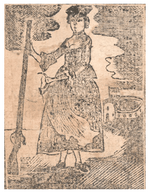

 I'll proably bust it out of the slab one day in the future.
I'll proably bust it out of the slab one day in the future. 
